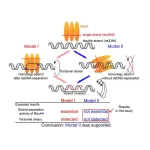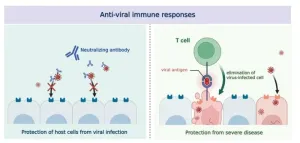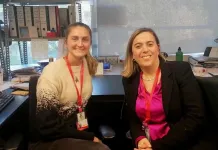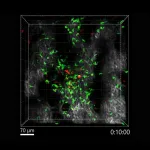Scientists unravel key steps in the road to DNA repair
Insights into homologous recombination (HR) promise new insights into cancer
2024-01-20
(Press-News.org)
Tokyo, Japan – Researchers from Tokyo Metropolitan University have been studying DNA repair by homologous recombination, where the RecA protein repairs breaks in double-stranded DNA by incorporating a dangling single-strand end into intact double strands, and repairing the break based on the undamaged sequence. They discovered that RecA finds where to put the single strand into the double helix without unwinding it by even a single turn. Their findings promise new directions in cancer research.
Homologous recombination (HR) is a ubiquitous biochemical process shared across all living things, including animals, plants, fungi, and bacteria. As we go about our daily lives, our DNA is subjected to all kinds of environmental and internal stress, some of which can lead to breakage of both strands in the double helix. This can be disastrous, and lead to imminent cell death. Luckily, processes like HR are continuously repairing this damage.
During HR, one of the two exposed ends of the break in the helix falls away, revealing an exposed single-stranded end; this is known as resection. Then, a protein known as RecA (or some equivalent) binds to the exposed single strand and an intact double strand nearby. Next, the protein “searches” for the same sequence. When it finds the right place, it recombines the single strand into the double helix in a process known as strand invasion. The broken DNA strand is subsequently repaired using the existing DNA as a template. HR enables accurate repair of double-strand breaks, as well as the exchange of genetic information, making it a key part of biodiversity. But the exact biochemical picture of HR, including what happens when RecA carries both the single and double strands, is not yet clear.
A team led by Professor Kouji Hirota of Tokyo Metropolitan University has been studying DNA repair mechanisms like HR. In their most recent work, they sought to test two competing models for what happens when HR occurs. In one, RecA unwinds a section of the double strand during the “homology search,” where it tries to find the right place for strand invasion to occur. In the second, there is no unwinding after the binding of RecA; only when strand invasion takes place does any unwinding occur.
The team, in cooperation with a team from the Tokyo Metropolitan Institute of Medical Science, adopted two approaches to tackle which of these actually happens. In the first, they used a mutant of RecA which cannot separate the double strands i.e. cannot unwind the strand, to see whether this affected DNA repair. It turns out that this has minimal effect. In the second, they tried to measure how much torsion was created in the strand at different stages of the process. They found that the only torsion due to unwinding they could detect occurred after the homology search was complete i.e. when strand invasion occurred. For the first time, the team clearly showed that the second model was correct.
Detailed insights into homologous recombination are vital to understanding what happens when things go wrong. For example, factors implicated in breast cancer (BRCA1 and BRCA2) are also responsible for the correct loading of single-stranded DNA onto RAD51, the human version of RecA. This suggests that problems with HR might underlie high incidences of breast cancer in patients with hereditary defects in BRCA1 or BRCA2. The team hopes findings like theirs will lead to new directions for research into cancer.
This work was supported by JSPS KAKENHI Grant Number JP22K06335.
END
[Attachments] See images for this press release:

ELSE PRESS RELEASES FROM THIS DATE:
2024-01-19
Programmed cell death 1 (PD-1) is an important target for immune checkpoint inhibitor therapies that block its signaling and boost T-cell activity. PD-1 inhibitors have been approved for treating various types of cancer.
But PD-1 functions can vary between different cell and cancer types, either promoting or suppressing disease progression. Merkel cell carcinoma (MCC), a rare and aggressive form of skin cancer, responds well to immune checkpoint inhibitor therapy. However, it was previously unknown if MCC cells express PD-1 themselves, and unclear how exactly cancer cell-intrinsic ...
2024-01-19
When Ben Brown, research assistant professor of chemistry, thinks about the opioid epidemic, he views the problem on a molecular level. Painkillers used legitimately in medicine, such as oxycodone, are highly addictive, but better understanding of how their molecules interact with proteins in the body could lead to the formulation of nonaddictive alternatives, he said.
In May, the National Institute on Drug Abuse awarded Brown $1.5 million over five years to further his work in this area. Brown, faculty affiliate of the Vanderbilt Center for Addiction Research and the Center for Applied Artificial Intelligence in Protein Dynamics, is developing artificial intelligence that ...
2024-01-19
The National Champion Tree Program started 83 years ago at American Forests to discover the largest, living trees in the United States. Now, the program is moving from the organization’s headquarters to a new home in the School of Natural Resources at the University of Tennessee Institute of Agriculture (UTIA).
American Forests launched the Champion Tree Program in 1940. Its vision included establishing a nationwide laboratory for the study of forestry and trees. Being housed at Tennessee’s 1862 public land-grant university will advance the program’s understanding of big trees. “The National Champion Tree Program moving to UTIA means it can continue protecting ...
2024-01-19
Des Plaines, IL — A new study that contributes additional data to a growing body of evidence demonstrating disparities in restraint use in the emergency department (ED) has been published in the January issue of Academic Emergency Medicine (AEM), the peer-reviewed journal of the Society for Academic Emergency Medicine (SAEM). The study, titled Disparities in use of physical restraints at an urban, minority-serving hospital emergency department evaluates the association between race/ethnicity and the use of restraints in an ED population ...
2024-01-19
Using CRISPR, an immune system bacteria use to protect themselves from viruses, scientists have harnessed the power to edit genetic information within cells. In fact, the first CRISPR-based therapeutic was recently approved by the FDA to treat sickle cell disease in December 2023. That therapy is based on a highly studied system known as the CRISPR-Cas9 genetic scissor.
However, a newer and unique platform with the potential to make large-sized DNA removals, called Type I CRISPR or CRISPR-Cas3, waits in the wings for potential therapeutic use.
A new study from Yan Zhang, ...
2024-01-19
It has been 4 years since the start of the COVID-19 pandemic. SARS-CoV-2 has yet to be eradicated and new variants are continuously emerging. Despite the extensive immunization programs, breakthrough infections (infection after vaccination) by new variants are common. New research suggests that human immune responses are also changing in order to combat the never-ending emergence of new SARS-CoV-2 variants. Specifically, it has been discovered the immune system that encountered breakthrough infection by the Omicron variant acquires enhanced immunity against future versions of the Omicron.
A team of South Korean scientists ...
2024-01-19
A team led by Dr. Guadalupe Sabio at the Centro Nacional de Investigaciones Cardiovasculares (CNIC) in Madrid has discovered a possible therapeutic target for pulmonary hypertension.
The study, published in the journal Science Advances, identifies the first therapeutic target that can be modulated to preserve cardiac function in pulmonary hypertension, providing hope in the fight against this rare but fatal disease for which there is currently no cure.
Pulmonary hypertension is a condition of elevated blood pressure in the arteries that carry deoxygenated blood to the lungs. This increased pulmonary blood pressure puts the heart under continuous strain ...
2024-01-19
Scientists working on biological design should focus on the idiosyncrasies of biological systems over optimisation, according to new research.
In a study, published today in Science Advances, researchers from the Universities of Bristol and Ghent have shown how exploring the unknown may be the crucial step needed to realise the continual innovation needed for the biotechnologies of the future.
Recognising the role of open-endedness in achieving this goal and its growing importance in fields like computer science and evolutionary biology, the team mapped out how open-endedness is linked to bioengineering practice today and what would be required to achieve it in ...
2024-01-19
In the study led by the Peter Doherty Institute for Infection and Immunity (Doherty Institute) and published in Science Immunology, the researchers found that CD4+ T cells, traditionally called ‘helper T cells’ for their role in aiding the activation of other immune cells, are remarkably effective in controlling melanoma.
University of Melbourne’s Dr Emma Bawden, Postdoctoral Researcher at the Doherty Institute and lead author of the study, said this discovery challenges the conventional understanding of the role of CD4+ T cells in cancer immunity.
“Our ...
2024-01-19
A team of scientists led by a Tulane University oceanographer has found that deposits deep under the ocean floor reveal a way to measure the ocean oxygen level and its connections with carbon dioxide in the Earth's atmosphere during the last ice age, which ended more than 11,000 years ago.
The findings, published in Science Advances, help explain the role oceans played in past glacial melting cycles and could improve predictions of how ocean carbon cycles will respond to global warming.
Oceans adjust atmospheric CO2 as ice ages transition to warmer climates by releasing the greenhouse ...
LAST 30 PRESS RELEASES:
[Press-News.org] Scientists unravel key steps in the road to DNA repair
Insights into homologous recombination (HR) promise new insights into cancer






